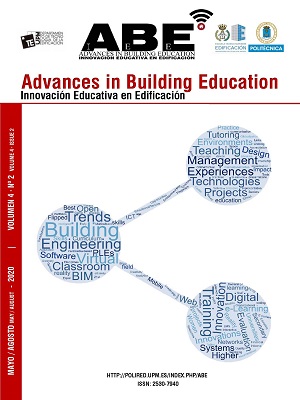Implementación del aprendizaje basado en proyectos a través de la tecnología BIM = Implementing Project-Based Learning through BIM Technology
DOI:
https://doi.org/10.20868/abe.2020.2.4462Palabras clave:
Aprendizaje Basado en Proyectos, BIM, proyectos de ingeniería, innovación educativa, Project-Based Learning, engineering projects, educational innovationResumen
Debido a las exigencias del panorama profesional actual, surge la necesidad de desarrollar competencias transversales durante la etapa universitaria que faciliten su inserción laboral. Una metodología docente que resulta adecuada en las ingenierías es el aprendizaje basado en proyectos. Implementarlo a través de la metodología BIM reforzará la adquisición de estas competencias transversales a los estudiantes. Este trabajo muestra el marco de trabajo desarrollado para implementar el aprendizaje basado en proyectos a través de la tecnología BIM en ambientes educativos de ingeniería de proyectos. Los resultados ponen de manifiesto una mejor comprensión del proyecto por parte de los alumnos que deriva en una mejora cualitativa de las soluciones técnicas proyectadas.
Abstract
The engagement of engineers from various specialties is demanded by construction projects to ensure their success. Its main consequence is the need to create collaborative working environment. Consequently, one of the most demanded competence in professional activity nowadays is the ability to carry out projects in multidisciplinary teams. Project-based learning is a suitable tool for improving this skill in construction projects engineering students.
This paper focuses on showing the framework developed for implementing project-based learning through Building Information Modelling (BIM) technology in engineering construction education environments. A collaborative framework managed by BIM execution plan was established. This document assigns roles and tasks for each member of the team, who work on the same digital file hosted in a cloud. Furthermore, it establishes the characteristics and timing of project’s deliverables.
The results show a qualitative enhancement in the quality of the work developed by the students with respect to 2D technology previously implemented. Keeping track of their partner’s work improves coordination to design compatible solutions. So, a better coordination among engineers is the reason of this improvement. This methodology aids to develop transversal competences of engineering students by favouring their performance in multidisciplinary teams.
Descargas
Referencias
R. Hernandez-Linares, J. Agudo, M. Rico and H. Sanchez, “Transversal Competences of University Students of Engineering,” Croatian Journal of Education, vol. 17, no. 2, pp. 383-409, 2015.
J. Perkins, Professor John Perkins' Review of Engineering Skills, London, UD: Department of Business Innovation and Skills, 2013.
R. Morgan and S. Ion, The Universe of Engineering: A Call to Action, London, UK: Royal Academy of Engineering, 2014.
R. Hernández-Linares, J. Agudo, M. Rico and H. Sánchez, “Transversal competences of university students of engineering,” Croatian Journal of Education, vol. 17, no. 2, pp. 383-409, 2015.
K. Jeon, O. Jarret and H. Ghim, “Project-based learning in engineering education: is it motivational?,” International Journal of Engineering Education, vol. 30, no. 2, pp. 438-448, 2014.
R. Charef, H. Alaka and S. Emmitt, “Beyond the third dimension of BIM: A systematic review of literature and assessment of prefessional views,” Journal of Building Engineering, vol. 19, pp. 242-257, 2018.
A. Candelario-Garrido, A.M. Reyes Rodríguez and J. García-Sanz-Calcedo, “A quantitative analysis on the feasibility of 4D Planning Graphic Systems versus Conventional Systems in building projects,” Sustainable Cities and Society, vol. 35, pp. 378-384, 2017.
A. Rad, T. Popa, V.-D. Mihon and B. Iancu, “Problem-based learning and project-based learning concepts and their applications to engineering education,” in 16th RoEduNet Conference: Networking in Education and Research, Targu Mures, Romania, 2017.
A. Kolmos and E. de Graaff, “Problem-based and project-based learning in engineering education mergin models,” in Cambridge Handbook of Engineering Education Resarch, Cambridge, England, Cambridge University Press, 2014, pp. 141-160.
K. Yamaguhi, H. Kawazoe, Y. Kondo and S. Sakamoto, “Problem-based learning programs aiming at practical application of knowledge of specialized subjects,” Aviation Industry Press, pp. 1001-1006, 2004.
J. Zhang, H. Xie and H. Li, “Project-based learning with implementation planning for student engagement in BIM classes,” International Journal of Engineering Education, vol. 35, no. 1, pp. 1-13, 2019.
W. Wu and B. Hyatt, “Experimental and project-based learning in BIM for sustainable living with tiny solar houses,” Procedia Engineering, vol. 145, pp. 579-586, 2016.
W. Chong, J. Chang, K. Parrish and U. Berardi, “Sustainable Design with BIM Facilitation in Project-based Learning,” Procedia Engineering, vol. 118, pp. 819-826, 2015.
F. Zamora-Polo, M. Martínez Sánchez-Cortes, A.M. Reyes-Rodríguez and J. García-Sanz-Calcedo, “Developing Project Managers’ Transversal Competences Using Building Information Modelling,” Applied Science, vol. 9, p. 4006, 2019.
R. Kreider and J. Messner, The uses of BIM. Classifying and Selecting BIM Uses, PA, USA: The Pennsylvania State University, Universtity Park, 2013.
Descargas
Publicado
Número
Sección
Licencia
Derechos de autor 2021 Autor / BY-NC-ND

Esta obra está bajo una licencia internacional Creative Commons Atribución-NoComercial-SinDerivadas 4.0.
ABE (Advances in Building Education / Innovación Educativa en la Edificación) no aplica cargo alguno a los autores por procesar o publicar un artículo y provee acceso abierto (Open Access) inmediato a su contenido. Todo el contenido está disponible gratuitamente sin cargo para el usuario o su institución. Se permite a los usuarios leer, descargar, copiar, distribuir, imprimir, buscar o vincular a los textos completos de los artículos, o utilizarlos para cualquier otro propósito lícito, sin pedir permiso previo del editor o el autor. Esto está de acuerdo con la definición de acceso abierto de la BOAI.
1. Los autores conservan los derechos de autor y garantizan a la revista el derecho de una Licencia Creative Commons Atribución / No Comercial / No Derivadas 4.0 Internacional (CC BY NC ND) que permite a otros compartir el trabajo con un reconocimiento de la autoría y uso no comercial.
2. Los autores pueden establecer por separado acuerdos adicionales para la distribución no exclusiva de la versión de la obra publicada en la revista (por ejemplo, situarlo en un repositorio institucional o publicarlo en un libro).
Salvo indicación contraria, todos los contenidos de la edición electrónica se distribuyen bajo una licencia de uso y distribución “Creative Commons".














